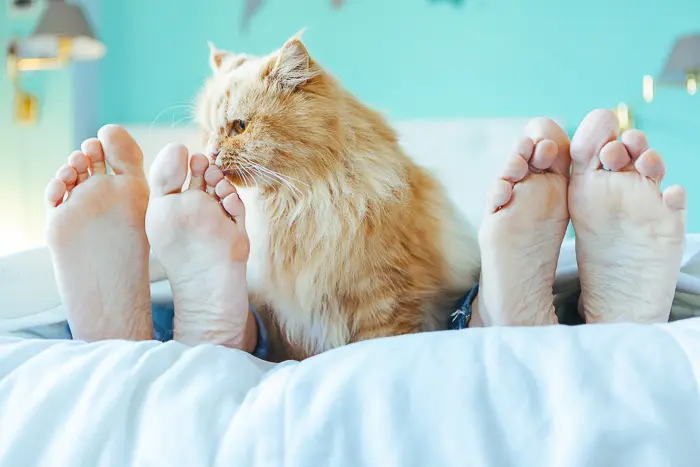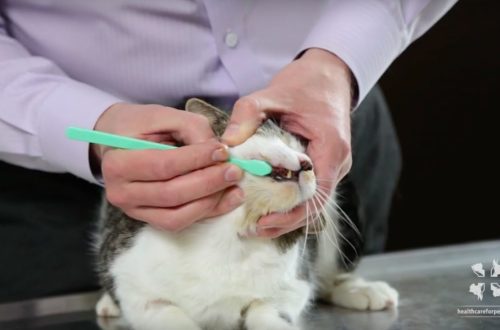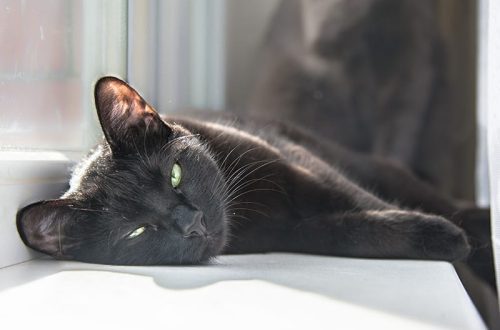
Why do cats sleep at the feet of humans?
Contents
Why do cats lie down at the owner’s feet?
Cats are smart and understudied animals. Many owners try to explain their social behavior by comparing them to dogs. This is fundamentally wrong, because cats are radically different animals. They are very stress resistant. If you do not find an approach to them, then in the future this may provoke the onset of the disease, for example,
cystitisInflammation of the lining of the bladder, or unscrupulous behavior of cats in the house (urinary marks).
Cats in the wild can live alone or in families.
It depends on the amount of resources in the environment. If there are many of them, then social groups are formed – colonies, in order to protect the best habitats.
Cats communicate with each other in different ways. To understand why a cat lies on its feet at home, you need to understand the communication methods and physiological characteristics of these animals.
It is also important to take into account the individual characteristics of the character of each cat. After all, it was not without reason that in the old days people invented signs and legends about cats. These are very interesting, freedom-loving animals.
Tactile communication
Lying next to the owner. Many people think that the answer to the question of why a cat sleeps at a person’s feet is to keep warm. This answer is very logical, because these animals love to sleep in warmth and soft places. But how to explain this behavior in warm weather with a constant air temperature in the apartment? Zoopsychologists believe that this is how pets establish and strengthen friendships.
Rubbing against the owner. Often, in addition to the fact that the animal sleeps at the feet of the owner, the pet rubs against the legs. Another reason why a cat sleeps at its feet may be the exchange of smells. This is how he acknowledges that you are part of the family.
Physiological features
Longing for warmth. Contrary to scientific evidence that cats snuggle up to each other even in hot weather, there are a number of owners who claim that only in case of a cold snap, the pet comes to bed. This version also has the right to exist. It is possible that the desire for warmth is the reason for sleeping on the bed, where a person performs the function of a warming battery.
Situation control. Being close to a person, cats can control the situation in the house, because they know where the owner is and what he is doing. In fact, in the bed, the most mobile place in case of a threat is the legs – there is no need to be afraid that you will be crushed. Cats, in principle, love heights – cabinets, shelves – to observe what is happening around.
This is where the scientific explanation ends.
Behavioral features
Attachment. If your pet comes to your bed, purrs, asks for attention, then most likely he feels affection and love for you. And if at the legs he falls apart with his tummy up, then he also shows confidence, since the stomach is the softest and most unprotected place. The main thing is not to rejoice and not to stroke his stomach, because it is unpleasant for them.
Recognition of the leader in the house. There is an opinion that if a pet lies down at its feet, then in this way it recognizes the leader of the colony in a person and accepts its secondary role. This is applicable only if the cat chooses one person in the house with whom he constantly sleeps.
Ownership. Rubbing against the host can be not only tactile communication, but also behavioral features. Because your cat’s scent will be obvious to other cats. So other cats will understand that a person belongs to a certain colony. So, firstly, the cat declares its rights to a part of the bed to other animals, if any. Secondly, it recognizes that the owner is above her in the hierarchy.
Signs
So, why do cats sleep at the feet of a person from the point of view of folk signs and what does this mean:
Esotericists claim that a person has a positive charge of energy in the head region, and a negative charge in the limbs. When a pet lies down at the owner’s feet, it absorbs negative energy or transforms it into positive energy.
There are more aggressive folk explanations for why cats sleep at their owner’s feet. They boiled down to the fact that co-sleeping with a cat – unfortunately soon.
You should not attach importance to this version, since these are folk fictions and superstitions.
Should you let your pet in the bed?
Each owner must make their own decision about co-sleeping with their pet. Unfortunately, having an animal in a bed has more minuses than pluses. Let’s take a look at them.
Benefits of co-sleeping with a cat in bed:
Establishing friendly contact;
Better understanding of the habits and actions of a pet;
Cons:
Propensity to develop allergic reaction – the presence of wool in the bed provokes the development of allergies in humans.
Infection the owner of the infection if the pet has
helminthic invasionParasitic disease caused by parasitic worms, flea infestation of fungal infections, such as lichen.
Risk of getting injuries in a pet – all people sleep differently: someone abruptly rolls over or moves during sleep. At such moments, it is difficult to control yourself and you can accidentally hurt the cat.
Risk of getting injuries the owner – all cats have a different temperament. Someone plays and bites the limbs, someone can scratch a sleeping person. In this case, it is better to try to wean the cat to sleep next to you.
disturbed sleep. Cats are nocturnal animals. If you have not accustomed your pet to your daily routine and sleep time in time, you may encounter a problem. The cat can run, play and in every possible way try to involve you in games, prevent you from sleeping.
How to wean a cat to climb into bed?
If you are determined to wean a cat to sleep next to you, then you need to understand that the process of weaning should include certain principles:
Provide the most private place to sleep. Choose the warmest, secluded and protected place for the cat to sleep.
Provide spacious space – the size of the bed should correspond to the size of the animal. Otherwise, the pet will be cramped. It is better to choose cardboard boxes, beds with walls and an open top.
Cats love to sleep on soft materials. If we are dealing with a basket, then it is better to put a pillow or a soft blanket in it.
Keep your sleeping area clean. Do not use household chemicals as cats are very sensitive to smells and do not like them. Best for cleansing is baby or household soap.
Consider the cats’ love of high places and the desire to observe everyone.
You can put your favorite toys and your own clothes next to the sunbed. So you add to the animal a sense of security and comfort.
You can use special diffusers for stress relief (for example, Feliway) so that the relearning process takes place as anti-stress as possible. These diffusers contain the hormone of a pregnant cat, which a person does not feel, but the cat feels and calms down.
Remember to never scold or forcefully interact with animals. Be patient and act step by step and with love.
Pay close attention to the above points and remember that cats are prone to stress. And any stress is easier to prevent than to deal with its consequences.
Sources:
Horwitz D., Mills D., Heath S. Guide to Behavioral Medicine for Dogs and Cats, 2005, 368 pp.





